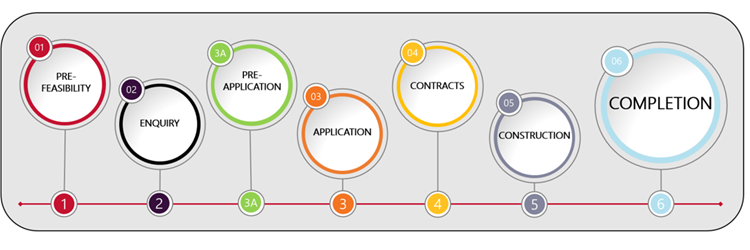Stage 6 - Completion

You can click through these bubbles to navigate to each Stage.
If they haven’t already done so, Connection Applicants should submit an application for registration to AEMO. The registration process is separate to the connection process and must be completed prior to commissioning, so Connection Applicants are encouraged to consider registration requirements as early as possible.
To assist with the registration process, Connection Applicants should ensure that:
- Complete simulation models of the connecting plant and associated design data are provided (see Modelling requirements page for more details).
- Plant design meets agreed performance standards.
- Supervisory Control And Data Acquisition (SCADA) system is ready – necessary to allow first synchronisation.
Connection Applicants should also submit to AEMO:
1. Commissioning program. AEMO suggests Connection Applicants consider this requirement as early as possible, and it must be agreed at least three months before commissioning starts. On-site testing must be conducted to demonstrate that the new/modified plant and equipment has been constructed in accordance with all regulatory and contractual obligations and meets its performance standards.
Each commissioning program should include:
- Commissioning test procedure – identifying specific tests and data that will be provided once results are available.
- Commissioning test schedule – setting out the expected timing of activities.
AEMO has produced a guideline on commissioning requirements and a template for commissioning and R2 testing plans (see the Related Guide and Policies section below).
2. Advice on material inter-network impact. This must be submitted at least 80 business days before expected synchronisation, if the facility will have such an impact. AEMO will determine if inter-network tests are required.
3. Commissioning results. These must be submitted within three months of completing commissioning. The commissioning report should demonstrate compliance with the relevant agreed performance standards. If the test results indicate the connecting system does not perform as expected, the plant's capability to meet the performance standards may require reassessment. Any non-compliance needs to be reported to AEMO (see AEMO’s non-compliance reporting page).
4. Finalised simulation models, R2 model validation report and data sheets. These must also be submitted within three months of completing commissioning. The R2 model validation report may be included as part of the commissioning report, using commissioning test data and network events data to verify the simulation model. An update of all R2 data must also be provided. If there are material changes to the simulation model, AEMO may need to re-assess the performance standards.
What to do next – compliance monitoring
Upon completion of the connection process, Connection Applicants should develop and implement a compliance monitoring program as required by clause 4.15 of the National Electricity Rules (Rules), in respect of the performance standards. Compliance is crucial to maintaining power system security.
Monitoring of some performance standards (such as those associated with clauses S5.2.5.4 and S5.2.5.5 of the Rules) can only be achieved by permanently installing high speed data recorders which capture network events as they occur. AEMO strongly recommends such monitors are installed, especially for distributed generation, such as wind and solar generating systems.
For more information, please see the Compliance Monitoring Template published by the Australian Energy Market Commission (AEMC) (see AEMC’s compliance monitoring pages).
Roles and responsibilities summary
AEMO: review and approve commissioning plans, process applications for registration, review performance at successive hold points.
Connection Applicant: provides updated data, commissioning programs, test results and simulation models to AEMO, finalises registration application requirements, and proposes amended performance standards (if necessary).






